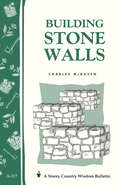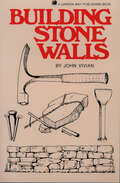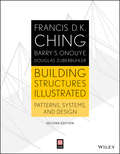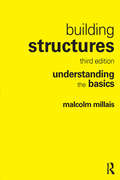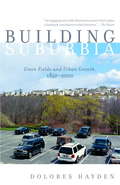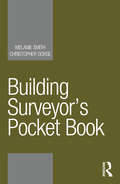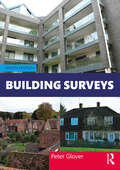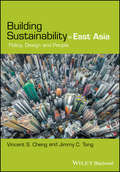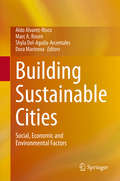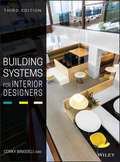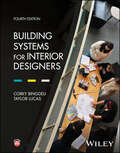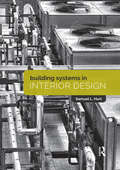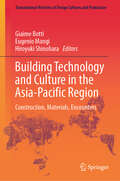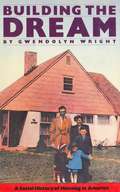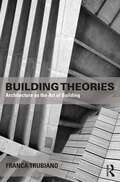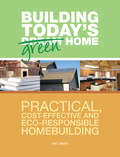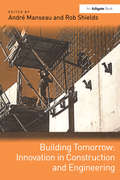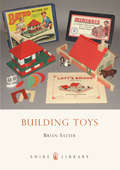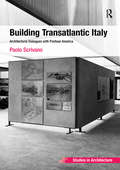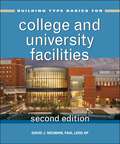- Table View
- List View
Building Stone Walls: Storey's Country Wisdom Bulletin A-217
by Charles McRavenSince 1973, Storey's Country Wisdom Bulletins have offered practical, hands-on instructions designed to help readers master dozens of country living skills quickly and easily. There are now more than 170 titles in this series, and their remarkable popularity reflects the common desire of country and city dwellers alike to cultivate personal independence in everyday life.
Building Stone Walls: Storey's Country Wisdom Bulletin A-217
by John VivianRustic and charming or stately and proud, a well-built stone wall can add personality and beauty to your property. John Vivian’s lively approach and step-by-step instructions encourage you to transform a pile of rocks into an enduring landscape feature with gates, retaining walls, or stiles to suit your needs. Whatever unique challenges come with your site — poor drainage, sloping ground, or low-quality rubble material — Vivian offers innovative designs and reproducible methods to help you build a beautiful, long-lasting wall.
Building Strong Bridges (Fun STEM Challenges)
by Marne VenturaWhat does it take to make a strong bridge? Gather some supplies and try it out for yourself! Discover tips and ideas on how to build the best bridge around!
Building Structures Illustrated
by Francis D.K. Ching Barry Onouye Douglas ZuberbuhlerA new edition of Francis D. K. Ching's illustrated guide to structural design Structures are an essential element of the building process, yet one of the most difficult concepts for architects to grasp. While structural engineers do the detailed consulting work for a project, architects should have enough knowledge of structural theory and analysis to design a building. Building Structures Illustrated takes a new approach to structural design, showing how structural systems of a building--such as an integrated assembly of elements with pattern, proportions, and scale--are related to the fundamental aspects of architectural design. The book features a one-stop guide to structural design in practice, a thorough treatment of structural design as part of the entire building process, and an overview of the historical development of architectural materails and structure. Illustrated throughout with Ching's signature line drawings, this new Second Edition is an ideal guide to structures for designers, builders, and students. Updated to include new information on building code compliance, additional learning resources, and a new glossary of terms Offers thorough coverage of formal and spatial composition, program fit, coordination with other building systems, code compliance, and much more Beautifully illustrated by the renowned Francis D. K. Ching Building Structures Illustrated, Second Edition is the ideal resource for students and professionals who want to make informed decisions on architectural design.
Building Structures: understanding the basics
by Malcolm MillaisThis is a one-stop book for knowing everything important about building structures. Self-contained and with no prerequisites needed, it is suitable for both general readers and building professionals. follow the history of structural understanding; grasp the concepts of structural behaviour via step-by-step explanations; apply these concepts to a simple building; see how these concepts apply to real buildings, from Durham Cathedral to the Bank of China; use these concepts to define the design process; see how these concepts inform design choices; understand how engineering and architecture have diverged, and what effect this had; learn to do simple but relevant numerical calculations for actual structures; understand when dynamics are important; follow the development of progressive collapse prevention; enter the world of modern structural theory; see how computers can be used for structural analysis; learn how to organise and design a successful project. With more than 500 pages and over 1100 user-friendly diagrams, this book is a must for anyone who would like to understand the fascinating world of structures.
Building Suburbia: Green Fields and Urban Growth, 1820-2000
by Dolores HaydenIn this study of 180 years of US metropolitan development, urban historian and architect Hayden (American studies, Yale U. ) examines the often conflicting visions that have shaped landscapes from Levittown to a prototype digital home. Older suburbs are deemed key to sustaining livability. Includes period illustrations. Annotation ©2004 Book News, Inc. , Portland, OR (booknews. com)
Building Sunshades (Fun STEM Challenges)
by Marne VenturaWhat does it take to make a sunshade? Gather some supplies and try it out for yourself! Discover tips and ideas on how to build the best sunshade around!
Building Surveyor’s Pocket Book (Routledge Pocket Books)
by Melanie Smith Christopher GorseBuilding Surveyor’s Pocket Book is an accessible encyclopaedia of matters vital to building surveyors. Well-illustrated with diagrams, pictures, tables, and graphs, it covers all essential elements of building pathology, building performance, and building construction terminology in a simple, accessible way for the practitioner and student. This Pocket Book provides a practical and portable reference text, working as a first-stop publication for those wishing to refresh their knowledge or in need of guidance on surveying practice. Working through fundamental principles in key practice areas, the book is not overly bound by the regulation and legislation of one region, and the principles can be applied internationally. This book is ideal reading for individual surveyors, practitioners, and students in building surveying, facilities management, refurbishment, maintenance, renovation, and services management. It is also of use for those interested in building forensics, building performance, pathology, and anyone studying for their RICS APC. Many other professions in architecture, contracting, engineering, and safety will also find the book of use when undertaking similar practice.
Building Surveys
by Peter GloverBuilding Surveys has been a trusted guide for both students and professionals for nearly 40 years, evolving throughout its nine editions to address the challenges and responsibilities of the building surveying role. It covers everything needed for initial inspections such as equipment, know-how and procedures to writing an accurate report, making it indispensable to those practising in or studying this field. • This updated Ninth Edition features new material on modern methods of construction, new sustainable materials, new surveying technologies and industry developments in the wake of the Grenfell Fire. • Essential reading for building construction students, professional surveyors and others who may be required to inspect and report on buildings. • Illustrated throughout with colour photos showing examples of building defects in full detail. All the structural aspects of property surveying are explained, covering foundations, walls and roofs as well as what to look out for and how to deal with problems. Materials and techniques no longer in use are covered as well as new technologies, so the reader is prepared for anything they might encounter. Legal considerations and recent cases are also used to illustrate good working practice, making this an extremely practical companion to the subject.
Building Sustainability in East Asia: Policy, Design and People
by Jimmy C. Tong Vincent S. ChengBuilding Sustainability in East Asia: Policy, Design and People illustrates the holistic approaches and individual strategies to building sustainability that have been implemented in construction projects in Asia. Top-down and bottom-up approaches (from formulating policy to constructing individual buildings) are effective in terms of the sustainable development of cities, and this book covers both, illustrated with a range of case study developments.
Building Sustainable Cities: Social, Economic and Environmental Factors
by Marc A. Rosen Aldo Alvarez-Risco Dora Marinova Shyla Del-Aguila-ArcentalesThis book describes a broad view of sustainability as a crucial factor for the success of its implementation. Not only the environmental aspects of the sustainable cities´ development are reviewed but the economic and social aspects of it, as highlighted in the UN Sustainable Development Goal 11 (make cities and human settlements inclusive, safe, resilient and sustainable).Nowadays, researchers, students, and stakeholders are highly involved in sustainability issues. Because of this, they need a guiding document to help them develop and implement sustainability programs at the level of companies and institutions.In this book, the authors discuss and explain basic concepts of sustainability-related to social, economic and environmental aspects, as well as strategies for its implementation.
Building Sustainable Futures: Design and the Built Environment
by Mohammad Dastbaz Ian Strange Stephen SelkowitzThis book presents state-of-the-art research and case studies on new approaches to the design, construction and planning of our cities. Emphasis is placed on the role of alternative and renewable energy in the development of urban infrastructures that enable sustainable futures. Reflecting the multi-faceted efforts required to successfully meet sustainability challenges, this book is a collaboration between practitioners and academics across a broad spectrum of specializations. Compelling research findings are explained in the context of practical implementation, enhanced by case studies from industry leaders in order to create a pragmatic reference across policy areas where environmentally aware decision making is required.
Building Sustainable Information Systems: Proceedings Of The 2012 International Conference On Information Systems Development
by Michael Lang Christoph Schneider Chris Barry Henry Linger Julie Fisher Andrew BarndenInformation Systems (IS) as a discipline draws on diverse areas including, technology, organisational theory, management and social science. The field is recognized as very broad and encompassing many themes and areas. However, the development of artefacts, or information systems development (ISD), in the broadest sense, is a central concern of the discipline. Significantly, ISD impacts on the organisational and societal contexts through the use of the artefacts constructed by the development. Today, that impact also needs to be evaluated in terms of its effects on the environment. Sustainable, or "green," IT is a catch-all term used to describe the development, manufacture, management, use and disposal of ICT in a way that minimizes damage to the environment. As a result, the term has many different meanings, depending on the role assumed in the life span of the ICT artefact. The theme of the proposed work is to critically examine the whole range of issues around ISD from the perspective of sustainability. Sustainable IT is an emerging theme in academic research and industry practice in response to an individual concern for the environment and the embryonic regulatory environments being enacted globally to address the environmental impact of ICT. In this work we intend to bring together in one volume the diverse research around the development of sustainable IS.
Building Systems for Interior Designers
by Corky BinggeliBuilding Systems for interior designersSecond EditionCorky Binggeli, asidThe updated guide to technical building systems for interior designersAs integral members of the building design team, interior designers share an increasingly complex and crucial role. Now revised in its second edition, Building Systems for Interior Designers remains the one go-to resource that addresses the special concerns of the interior designer within the broader context of the rest of the building design team. Building Systems for Interior Designers, Second Edition explains technical building systems and engineering issues in a clear and accessible way to interior designers. Covering systems from HVAC to water and waste to lighting, transportation, and safety, author Corky Binggeli enables interior designers to communicate more effectively with architects, engineers, and contractors; collaborate effectively on projects; and contribute to more accurate solutions for a broad range of building considerations.Among the many improvements in the Second Edition are: A deeper engagement with sustainable building design, giving the interior designer the resources needed to participate as part of a sustainable design team A reshaped structure that enhances the reader's understanding of the material Many more illustrations and explanatory captionsWith a host of features to make the book more up to date, easier to use, and more effective as an instructive guide, Building Systems for Interior Designers, Second Edition is a valuable book for students as well as a practical desktop reference for professionals.
Building Systems for Interior Designers
by Corky Binggeli Taylor LucasBUILDING SYSTEMS FOR INTERIOR DESIGNERS Make design decisions informed by technical and structural knowledge with this essential guide Professional interior design demands more than simply an understanding of aesthetic and artistic considerations; it also requires a detailed understanding of building systems and their interactions. Design decisions must account for mechanical and electrical equipment, building components, and structural elements, all of which can potentially shape a designer’s work. Building Systems for Interior Designers has long stood as the key to understanding and evaluating these elements, particularly key building systems like HVAC and plumbing, and their impacts on interior design. This Fourth Edition is fully updated to fit the needs of the CIDA certified interior design program and the NCIDQ exam. The fourth edition of Building Systems for Interior Designers also includes: Updated information on sustainable and energy-efficient design Detailed coverage of topics including security concerns, fire safety, and designing secure spaces Classroom supplements including sample construction documents, chapter specific discussion questions, and more Building Systems for Interior Designers is ideal for students in interior design courses and new professionals studying for NCIDQ exams.
Building Systems in Interior Design
by Samuel L. Hurt<p>Building Systems in Interior Design takes an entirely new approach to teaching this essential topic for Architects, Designers and Building Engineers. Written to prepare students for the real world and packed with practical examples, the book will foster an understanding of specific issues that are critical to those features of technical systems that most directly affect design. The book stresses the ever-present nature of these systems: they are everywhere, all the time. <p>Taking a design oriented view, it outlines what can and cannot be done, and provides the student with the know-how and confidence to defend and promote their design intent when working with other industry professionals. <p>Covering lighting, HVAC, plumbing and much more, the book is packed with key features to aid learning including: <p> <li>Numerous illustrations, plans and photographs <li>Key terms defined in an extensive glossary <li>Chapter introductions that identify key concepts and chapter summaries to re-visit those key concepts <li>Professional design tips <li>And a detailed bibliography and web links</li> <p> <p>This book is not only a core text for interior design, building systems engineering and architecture students but will become an essential working reference through their careers.</p>
Building Technology and Culture in the Asia-Pacific Region: Construction, Materials, Encounters (Transnational Histories of Design Cultures and Production)
by Giaime Botti Eugenio Mangi Hiroyuki ShinoharaThis book compiles a curated selection of texts authored by architects and scholars hailing from Asia, Europe, and North America. Their research, often intertwined with practical applications, delves into the intricate relationship between material culture, technology, and architecture within the broader cultural and social milieu. Three keywords—construction, materials, encounters—serve as the organizing framework for the book, guiding readers through a diverse array of case studies and experiences where these elements intertwine seamlessly. Indeed, these terms are intricately interwoven, reflecting the inseparability of technology from culture.The first part of the book delves into the poetics and theoretical underpinnings of construction, drawing from the works of various designers across China, Japan, and India. The subsequent section navigates the terrain of construction materials, exploring their evolution, manufacturing processes, and utilization, with a particular focus on diverse timber products and bamboo. The final part of this compilation embarks on a journey through historical encounters between the East and West spanning over a century. It meticulously investigates the exchanges, misunderstandings, and innovations catalyzed by these interactions. Collectively, these texts offer a profound and original perspective on the myriad experiences and challenges associated with the intricate interplay between technological advancements, tectonic preferences, and socio-cultural dynamics within the architectural landscape of the Asia-Pacific region.
Building The Dream
by Gwendolyn WrightFor Gwendolyn Wright, the houses of America are the diaries of the American people. They create a fascinating chronicle of the way we have lived, and a reflection of every political, economic, or social issue we have been concerned with. Why did plantation owners build uniform cabins for their slaves? Why were all the walls in nineteenth-century tenements painted white? Why did the parlor suddenly disappear from middle-class houses at the turn of the century? How did the federal highway system change the way millions of Americans raised their families?Building the Dream introduces the parade of people, policies, and ideologies that have shaped the course of our daily lives by shaping the rooms we have grown up in. In the row houses of colonial Philadelphia, the luxury apartments of New York City, the prefab houses of Levittown, and the public-housing towers of Chicago, Wright discovers revealing clues to our past and a new way of looking at such contemporary issues as integration, sustainable energy, the needs of the elderly, and how we define "family."
Building Theories: Architecture as the Art of Building
by Franca TrubianoBuilding Theories speaks to the value of words in architecture. It addresses the author’s fascination with the voices of architects, engineers, builders, and craftspeople whose ideas about building have been captured in text. It discusses the content of treatises, essays, articles, and letters by those who have been, throughout history, committed to the art of building. In this, Building Theories argues for the return of a practice of architectural theory that is set amongst building, buildings, and builders. This journey of close reading reinterprets the words of Vitruvius, Alberti, de L’Orme, Le Camus de Mézières, Boullée, Laugier, Rondelet, Semper, Viollet-le-Duc, Hübsch, Bötticher, Berlage, Muthesius, Wagner, Behrendt, Gropius, and Arup. With chapters dedicated to texts from antiquity, the Renaissance, and the nineteenth century, and with a critical eye on architectural theory popularized in the Anglo-Saxon world post-1968, readers are introduced to a wider, more inclusive definition of architectural ideas. Building Theories considers how contemporary scholarship has steered away from the topic of building in its reluctance to admit that both design and construction are central to its concerns. In response, it argues for a realignment of architecture with the concept of techné, with a dual commitment to fabrica e ratio, with a productive return to l’art de bien bastir, with the accurate translation of the term Baukunst, and with an appeal to the architect’s ‘composite mind.’ Students, practitioners, and educators will identify in Building Theories ways of thinking that strive for the integration of design with construction; reject the supposed primacy of the former over the latter; recognize how aesthetics are an insufficient scaffold for subtending the subject of architectural ethics; and accept, without reservation, that material transformations have always been at the origins of built form.
Building Today's Green Home: Practical, Cost-Effective and Eco-Responsible Homebuilding
by Art SmithMake Your Green Home a Reality! Building the right-sized green home involves making eco-smart decisions. In Building Today's Green Home, you will learn: How to choose the correct location of your building lot and what is the optimum placement of your house to take advantage of solar energy How to design the right-sized home for your needs now and in the future What are the best sustainable construction materials to use for building your home About the newest insulation materials and techniques What HVAC units are the most efficient and are the best at saving energy How to grade the building lot for natural sustainability The decisions you make today will have a huge impact on your future and the future of your children. And, building the right-sized energy-efficient home will free up investment capital for your retirement years.
Building Tomorrow: Innovation in Construction and Engineering
by André ManseauIn the past decade construction and engineering have changed dramatically, with an explosion of innovative new approaches to construction and new methodologies. By bringing together economic, social and construction/engineering management perspectives, this book offers a unique and comprehensive survey of these approaches and techniques. It presents a history of studies in innovation in construction and engineering, and then presents the most recent models of innovation brokering and risk-management, based on complex project-based industries. Innovation is defined and competing theories are discussed in the light of operational issues. The book covers all aspects, including the importance of construction and engineering 'cultures' in the trades for successful project innovation. It also discusses the role of government and policy makers, the implications of rapid change for the building trades and skilled labour, and the difficulty of measuring innovation quantitatively.
Building Tough Towers (Fun STEM Challenges)
by Marne VenturaWhat does it take to make a tough tower? Gather some supplies and try it out for yourself! Discover tips and ideas on how to build the best tower around!
Building Toys
by Brian SalterBuilding blocks have been a familiar presence in children's toy collections for generations, but in the twentieth century new production techniques allowed the building brick to evolve into a multiplicity of systems that could make any child his or her own architect and skilled builder, capable of constructing realistic and sturdy miniature buildings. This highly illustrated book is devoted to British building toys with all the major brands and some of the minor ones represented. Photographs of sets, completed buildings and the box art and advertising material that were used to sell these toys make this book a feast of nostalgia for anyone who grew up in the middle years of the last century, and an invaluable source of information for any collectors who keep the memory of these toys alive today.From the Trade Paperback edition.
Building Transatlantic Italy: Architectural Dialogues with Postwar America (Ashgate Studies in Architecture)
by Paolo ScrivanoAt the end of the Second World War, America’s newly acquired status of hegemonic power- together with the launch of ambitious international programs such as the Marshall Plan- significantly altered existing transatlantic relations. In this context, Italian and American architectural cultures developed a fragile dialogue characterized by successful exchanges and forms of collaboration but also by reciprocal wariness. The dissemination of models and ideas concerning architecture generated complex effects and frequently led to surprising misinterpretations, obstinate forms of resistance and long negotiations between the involved parties. Issues of continuity and discontinuity dominated Italian culture and society at the time since at stake was the possible balance between allegedly long-established traditions and the prospect of a radical rupture with recent history. Architectural culture often contributed to reach a compromise between very diverging attitudes. Situated in the larger realm of studies on Americanization, this book questions current interpretations of transatlantic relations in architecture. By reconsidering the means and effects of the dialogue that unfolded between the two sides of the Atlantic during the postwar years, the volume analyzes how cultural and formal models were developed in one context and then modified when transferred to a new one as well as the fortune of this cultural exchange in terms of circulation, amplification, and simplification.
Building Type Basics for College and University Facilities
by David J. NeumanEssential information for the design of college and university facilities Building Type Basics for College and University Facilities, Second Edition is your one-stop reference for the essential information you need to confidently begin the planning process and successfully complete the design of college and university buildings, large or small, on time and within budget. Award-winning architect and planner David J. Neuman and a roster of industry-leading contributors share their firsthand knowledge to guide you through all aspects of planning higher education facilities, including learning centers, academic buildings and professional schools, scientific research facilities, housing, athletics and recreation facilities, social and support facilities, and cultural centers. The book combines up-to-date coverage of essential issues related to campus planning, programming, and building design guidelines with detailed project examples. This new edition offers: Numerous photographs, diagrams, plans, and sections Updated project examples, including several buildings completed in the last decade Up-to-date coverage of sustainability and technology issues A new chapter on historic preservation, rehabilitation, and adaptive use of existing buildings New material on the influence of interdepartmental collaboration and renewed communication on the built environment for campuses This conveniently organized quick reference is an invaluable guide for busy, dedicated professionals who want to get educated quickly as they embark on a new project. Like every Building Type Basics book, it provides authoritative, up-to-date information instantly and saves professionals countless hours of research.
